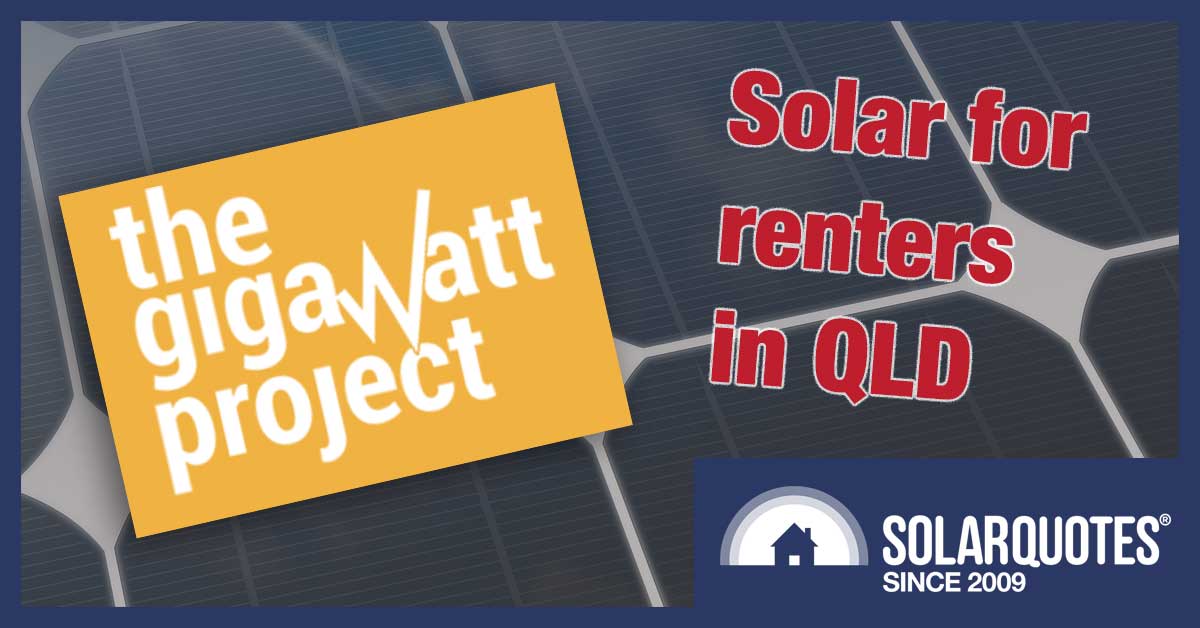
Another company who can help get solar on tenant’s roofs is the Gigawatt Project. Ronald looks over the details…
The Gigawatt Project is a Queensland company that helps put solar panels on the roofs of rental properties. They give tenants some of the savings from rooftop solar power while giving landlords a good enough return to make installing it worthwhile. In Queensland the Gigawatt Project can:
- Install a solar power system.
- Monitor tenant electricity use.
- Bill tenants for solar electricity they use at a rate less than the cost of grid electricity. The bill is paid to the landlord.
To get this the landlord has to pay for the solar power system and $10 a month for monitoring and billing. The Gigawatt Project can also install their energy monitor on an existing or new solar PV system anywhere in Australia for $1,0001.
While opinions vary on what is the best way to get solar panels on the roofs of rental properties, I can confidently state without fear of contradiction that using The Gigawatt Project is definitely a way.
The “Best” Ways To Get Solar On A Rental Roof
The best way to get solar put on the roof of a rental property depends on whether you are a tenant or a landlord:
- If you’re a tenant the best way to get solar is for your landlord to put it on your roof and let you get all the benefit without increasing your rent.
- If you are a landlord the best way is to have your tenant put solar on your roof at their expense and leave it as a gift to you when they move out.
While it’s not common, the first one certainly happens. Sometimes landlords just want to invest in their property and because they like you as a tenant they won’t increase your rent after installing solar. The system will lower your grid electricity use and pay a feed-in tariff for surplus solar electricity sent into the grid2.
The second example, where a tenant gifts a system to their landlord almost never happens – even though there are long term commercial leases where it could make sense. Outside of some very special cases, if you are a renter thinking of gifting a solar power system to your landlord, I first recommend you get a doctor of headology to inspect your head for damage.
Why Renters Would Want Landlords To Use The Gigawatt Project
If you’re a renter who wants some of the savings rooftop solar provides but can’t convince your landlord to install solar panels for free – or even in return for a reasonable increase in rent – then recommending they use The Gigawatt Project (or similar company) is a way to get a lower electricity bills at no cost to you.
Why Landlords May Want It
If you are a landlord, rather than put solar on the roof of your rental property yourself and then raise the rent to provide a return on that investment, you may prefer to go through a company such as The Gigawatt Project and let them handle the details.
Being A Middle Man For Fun & Profit & Saving The World
The Gigawatt Project will act as a middleman, or middleperson if you prefer, and requires compensation which will reduce the savings from solar shared between the renter and the landlord. Despite this there will still be people who find their services valuable. This means The Gigawatt Project’s rental monitoring service should result in more solar capacity than would otherwise be installed and this is a good thing for the planet.
How It Works
In Queensland The Gigawatt Project can install a solar power system for you and they do a good job of explaining how this works in the white on orange text below:
Rephrased into my own crude and primitive words with some additional information thrown in, they will:
- Install a system with an energy monitor at the landlord’s expense.
- As part of the lease, the tenant agrees to pay for solar electricity at a rate less than what they would be charged for grid electricity. The landlord determines the exact amount but the recommended maximum is 24 cents. The tenant also agrees to pay for each kilowatt-hour of solar feed-in tariff they receive at a rate less than the feed-in tariff. This is normally set at 7 cents.
- The Gigawatt Project uses their energy monitor to track the system’s performance and determine how much the tenant should pay.
- They send the tenant a bill, which means the tenant pays two bills for electricity. Their normal bill and one to their landlord.
- The tenant pays what they are billed to their landlord, usually in the same way they pay their rent.
Gigawatt Project Monitoring Is Available Outside QLD Or For Existing Systems
The Gigawatt Project uses a WattWatcher energy monitor and they can add one to a solar system anywhere in Australia for $1,000. This will allow their monitoring and billing service to be used for $10 a month. If the energy monitoring isn’t installed at the same time the solar power system is the landlord will need to pay an accredited solar installer to inspect it first.
Tenants Can’t Use The WattWatcher Monitor
Unfortunately, tenants can’t access the WattWatcher monitor to help them keep track of their electricity consumption. The Gigawatt Project says they can provide information to tenants but I expect this will very limited compared to direct monitoring.
The Energy Monitor Warranty Is For 2 Years
The WattWatcher energy monitor has a manufacturer’s warranty of 2 years. Hopefully it will last for much longer, but this is a much shorter than the warranty that comes with solar inverters or panels3.
Two Bills Does Not Mean Twice The Fun
One drawback of The Gigawatt Project’s method is the tenant ends up paying two bills. By law tenants must pay less in total than they would normally, but some people still won’t be happy about having their number of electricity bills doubled.
If my experience with humans is representative, a considerable number of people won’t understand, or will forget they have to pay a Gigawatt Project bill and will complain when their first one arrives. It also creates another potential point of dispute between tenants and landlords if people think the bill is incorrect.
The Gigawatt Project’s Smart Solar System’s Solar System
The Gigawatt Project can design a solar power system to suit a landlord’s particular needs and desires, but they also have a standard system specification for residential properties:
This system comes to 88 cents per watt, which is competitively priced. Jinko solar panels are not expensive but they are tier one and should be reliable. Zeversolar is a lower cost inverter. It is not considered as reliable as more expensive brands but, from what I have heard, it is good value for what you pay. The price also includes the WattWatcher energy monitoring system.
The system has 20 panels and they will fit on many roofs, but not all. Some roofs are too small to easily accommodate them and for those that can it is common for not all the panels to be able to face the best direction for maximizing output.
The Gigawatt Project Wants To Do Right By Customers
I am going to discuss the information provided in the Gigawatt Project’s “Landlord Starter Pack” and “Tenant Starter Pack”. These are not currently available online but are sent to potential clients. I am going to mention some things in it them that, in my opinion, are either wrong or could be improved. But I have spoken with people at The Gigawatt Project and they have strongly expressed willingness to make changes and improve the information they provide. So most or all of my criticism should soon be out of date.
Landlord Payback
The returns The Gigawatt Project’s Starter Pack says a landlord can expect when they install a 6.2 kilowatt system are shown in the graphic below:
Their annual output of 9,511 kilowatt-hours is a little better than what I would expect from a typical 6.2 kilowatt solar power system in Brisbane. The PVWatts site says a system with all its panels facing directly north will generate almost this much, but most homes aren’t going to be able to face all their panels directly north. The annual output the PVWatts site gives for different panel orientations in Brisbane are:
- All panels facing directly north = 9,420 kilowatt-hours
- 50% north and 50% east = 8,810 kilowatt-hours
- 50% north and 50% west = 8,880 kilowatt-hours
- 50% east and 50% west = 8,270 kilowatt-hours
If a typical system is considered one with half its solar panels facing north and the other half west, if it doesn’t suffer from significant shading, we could expect a new 6.2 kilowatt system in Brisbane to generate around 8,880 kilowatt-hours a year. Brisbane has 49% of Queensland’s population so a typical system is likely to be found there, but it is one of the least sunny locations in Queensland. An otherwise identical system in Townsville4 would generate around 5% more which is 9,300 kilowatt-hours a year.
The Gigawatt Project has said they will adjust the figures they use for annual generation.
Estimated Annual Income
The figures given for estimated annual income are incorrect as they don’t include the $120 a year cost of monitoring and billing. This should lower their estimate from $895 to $1,310 down to $775 to $1,190 which is a reduction of around 11%.
If the system generates 9,511 kilowatt-hours and the tenant is paying:
- The recommended maximum of 24 cents per kilowatt-hour of solar electricity consumed.
- The recommended 7 cents per kilowatt-hour of solar electricity sent into the grid for a feed-in tariff.
- And the cost of monitoring and billing continues to be ignored.
Then the starting figure for the estimated annual income of $895 assumes a solar self-consumption rate of 14%. While it is possible for solar self-consumption to be less than this it rarely goes below 10% so 14% isn’t too bad a figure to start with, but for tenants who are out for most of the day it could be less.
The estimated maximum amount for annual savings of $1,310 assumes a solar self-consumption rate of 40%. This is a good figure to use. While it is possible for tenants who are at home during the day and above average consumers of electricity to have self-consumption rates of over 50%, this is not common and I appreciate how The Gigawatt Project has used a conservative figure for their maximum instead of instead of going for a best case scenario.
Note that if the total kilowatt-hours generated is 7% less than what they estimate, which I think will often be the case, then the return will be around 7% less. While the reduction in return may be less than 7% as lower production tends to result in higher self consumption, the difference probably isn’t enough to worry about.
The Gigawatt Project has told me they will take into account how many kilowatt-hours a typical solar power system is likely to generate and include the $10 monthly cost of monitoring and billing in their estimated annual income and return figures.
Estimated Annual Return
The Gigawatt Project gives an estimated annual return of 16% to 24% and they determined this by simply dividing the estimated income by the $5,450 cost of a system.
After including the $120 a year cost of energy monitoring and billing the annual return would fall to 14% to 22% assuming its output matches the 9,511 kilowatt-hours figure they give. This does not include the cost of maintenance and repairs, but when the solar power system is new all the components are still under warranty so this should not amount to much early on. But this is the return on a physical asset that will gradually deteriorate and so it can’t be directly compared to a term deposit where you will get your capital back or the property or share market where, fingers crossed, you can also get your capital back. They are not misusing the term, but what I don’t approve of is this graph from their site where they give returns for different asset classes without making it clear they are not directly comparable:
When I pointed this out to The Gigawatt Project they indicated they would change it to make it clearer what type of return people can expect.
Income Over 25 Years
The Gigawatt Project gives an estimated income over 25 years of $22,440 to $32,820, which they obtained by simply multiplying their estimated annual income by 25. This is not correct, but before I go into that I’d like to congratulate The Gigawatt Project on what they did right. They did not assume that electricity prices would continue to increase forever. The massive increase in electricity prices Australians have suffered over the past decade or so is not normal. It is an aberration that cannot go on for another 10 years. The correct thing to do in these cases is to either assume the price of electricity will remain constant in real terms after inflation is accounted for, or to base estimates on some kind of evidence such as what future markets predict5. Picking a number out of a hat is just not on.
And now to point out what they got wrong:
- The cost of energy monitoring needs to be included.
- Repairs and maintenance need to be accounted for. While it would be nice to think a Zeversolar inverter can last an average of 25 years, with its competitive price and only 5 year warranty this is probably not the case.
- The decline of output over time needs to be allowed for. While this should only occur slowly I would expect the average output over 25 years to be at least 5% lower than the output in the first year.
So while the total income is not likely to be bad, it’s not going to be as high as they say. I would estimate it is more likely to be in the range of $15,000 to $25,000 given typical solar output in Brisbane, the cost of monitoring and billing, and modest costs for repairs and maintenance. The Gigawatt Project has said they will recalculate this figure.
Savings For Tenants
In the example The Gigawatt Project gives in their Renter Starter Pack, tenants save 8% on their electricity bills:
In this case the landlord has chosen to only charge 22 cents for each kilowatt-hour of solar electricity rather than the recommended 24 cents. But the 24 cents is a recommended maximum, not a minimum. Using The Gigawatt Project’s figure of 9,511 kilowatt-hours for annual generation, the family is self consuming 42% of the solar electricity generated. This seems too high as in their example no one is at home for most of the day. I’d expect their self consumption to be under 25% which will reduce their savings. Going by the figures they have given, if their self consumption is half as much as the 42% figure, their savings will be half as much and only around $100 a year which is 4%.
A saving of 4% isn’t much, but this example leaves out savings from feed-in tariffs. So if we assume:
- The property is outside of South East QLD in the Ergon Network area.
- They pay the current fixed price of 27.8 cents per kilowatt hour for QLD’s tariff 11.
- They receive the current fixed solar feed-in tariff of 9.4 cents.
- Their solar self consumption rate is 21%.
- Their landlord charges the recommended maximum of 24 cents for solar electricity they consume.
- Their system generates 9,511 kilowatt-hours a year, which is more likely outside of South East Queensland than in it.
Then they will save around $250 a year on their electricity bills which is 10%.
Renters Will Come Out Ahead — At Least By A Little
The Gigawatt Project is required by law to charge tenants less for electricity than their existing tariff, so tenants are sure to come out ahead. If tenants aren’t saving money they will alter the deal to ensure they do.

“I am altering the deal. Because that is fair and equitable.”
However, the amount tenants save is not likely to be much, especially if the landlord charges as much for solar consumption as they can. The tenants have no real power in this situation and so most of the benefit will go to the landlord with The Gigawatt Project taking their cut in the $10 monthly monitoring and billing fee. But while the savings in dollars may not be high, you can still feel great about the solar panels on your roof helping the environment and that feeling is worth a million bucks — provided you have the right attitude and an exchange ratio heavily weighted towards feelings rather than money.
The Gigawatt Project’s Smart Solar Plan Can Be Useful
If you are a renter and you can’t convince your landlord to install solar panels in return for a modest increase in rent — or better yet, no increase in rent — then you have nothing to lose by suggesting they use a service such as The Gigawatt Project’s Smart Solar plan. Well, you will have the hassle of having to deal with two bills for electricity, but you can decide for yourself how much of an inconvenience that is.
If you are a landlord then you have the option of just installing solar and then increasing the rent to account for it. But you may prefer to use the services of The Gigawatt Project. If you are in Queensland then the cost they charge for installing a system is competitive and paying $120 a year for monitoring and billing means you don’t have to increase the rent to pay for the solar power system.
Footnotes
- If the system is not new an accredited solar installer will first need to be paid to inspect it. ↩
- You lucky bastard! ↩
- Note you are protected by Consumer Guarantees in Australia and this protection can extend beyond the length of written warranties. ↩
- Also known as Redundant City as Towns-ville is Queensland’s entrant in the national redundantly named location contest. ↩
- Future markets predict a mild decrease in wholesale electricity prices on average over the next few years. ↩

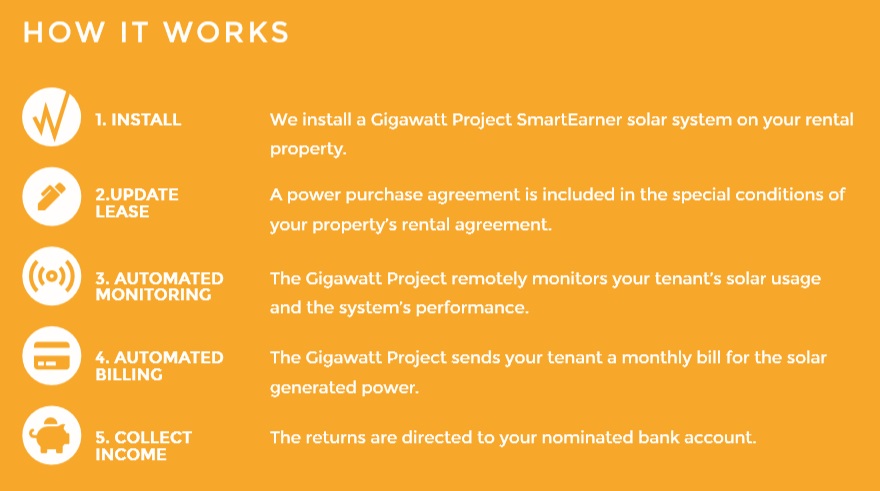

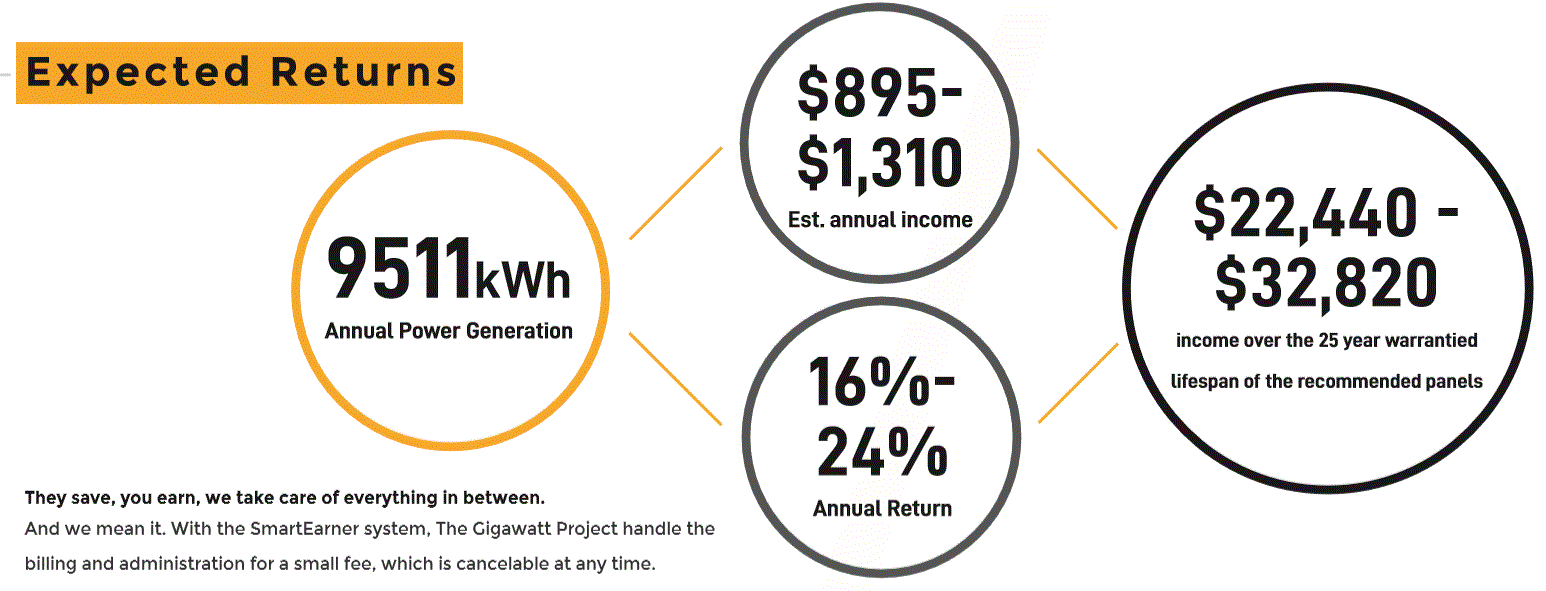
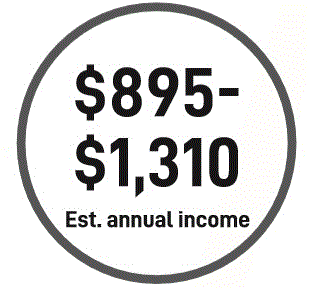
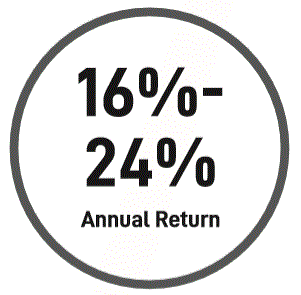

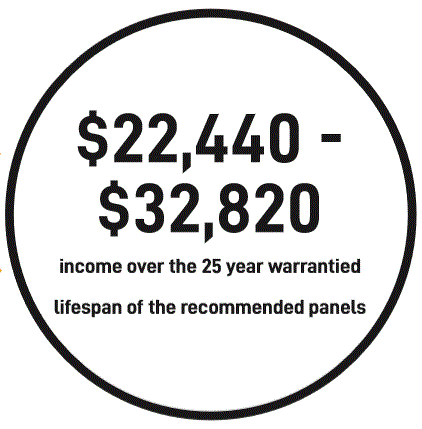
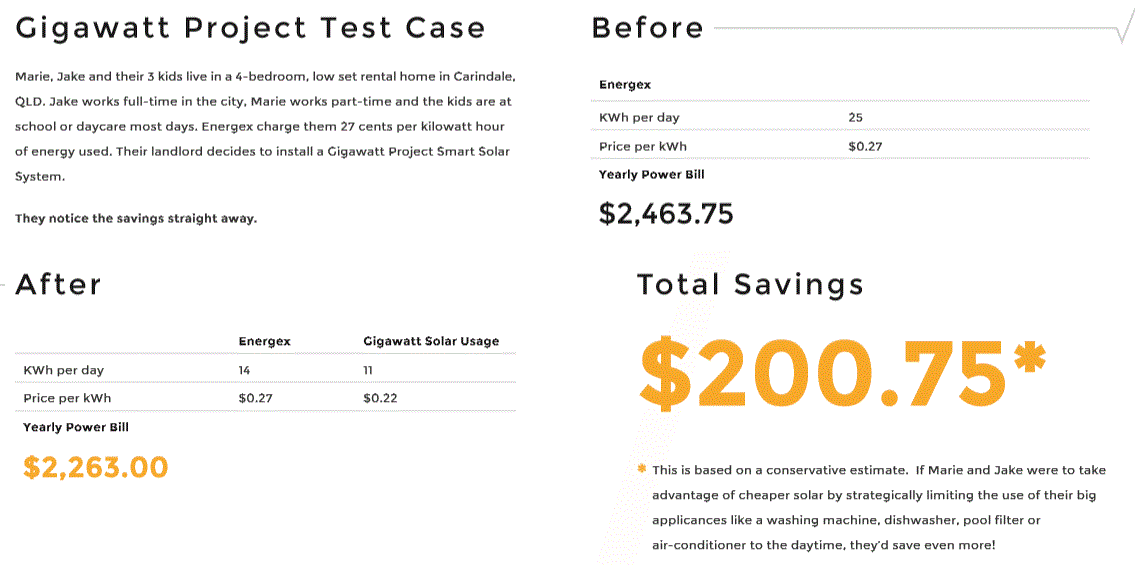
 RSS - Posts
RSS - Posts



Hi Ronald, re your two-option proposal:
“If you’re a tenant the best way to get solar is for your landlord to put it on your roof and let you get all the benefit without increasing your rent.
If you are a landlord the best way is to have your tenant put solar on your roof at their expense and leave it as a gift to you when they move out.”
There’s a third ‘best way’… . Pay for solar panels as a lessor without a rent increase and keep tenants long-term. Happy tenants who benefit from cheap energy _stay_ longer. This means far less vacancies, happier, and more respectful tenants.
As a lessor, you can claim depreciation… and eventually sell the rental for more. It’s long-term thinking.
One of the saddest emerging characteristics of our culture is an obsession with short-term gain. The example set ‘at the top’ doesn’t help, of course. Most of our politicians see no further than the next election… and their donors feed this poisonous short-term focus… .
$10 a month for monitoring and billing? Where does the queue start?